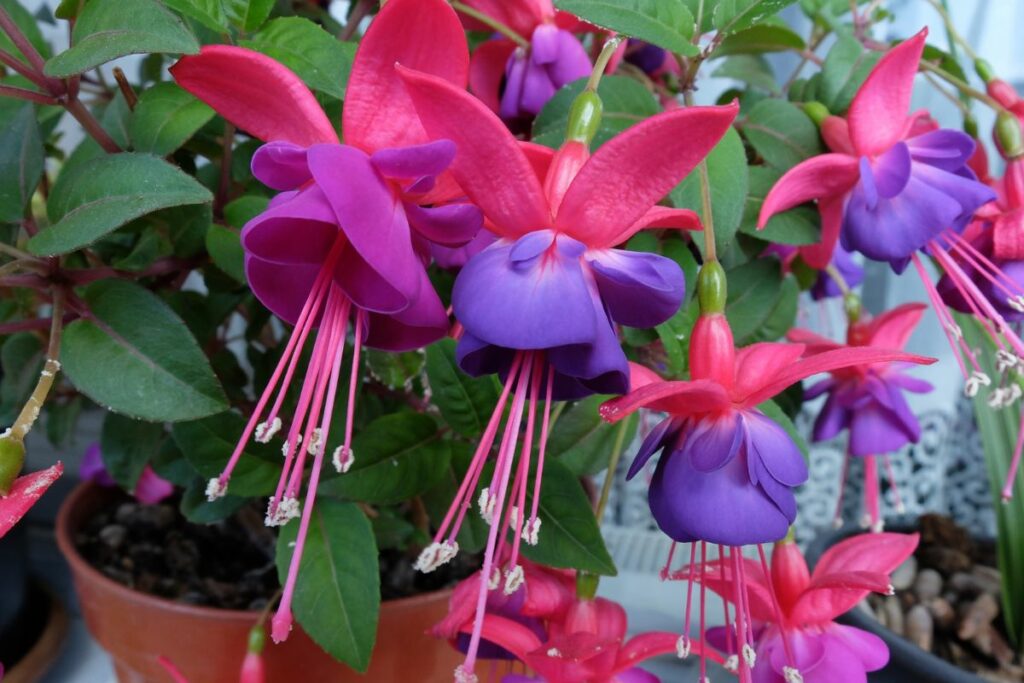Fuchsias are a garden enthusiast’s delight, offering both privacy and striking aesthetics to your outdoor space. These shrubs are effortless to cultivate and provide a lush backdrop with their vivid hues. It’s essential to prune them each year to maintain their vibrant display.
Understanding the difference between hardy and tender fuchsias is crucial because each type has its own specific pruning needs. Proper trimming ensures your fuchsias flourish and retain their charm season after season.
Comparing Resilient and Sensitive Fuchsias

When selecting fuchsias for privacy, understanding their resilience to climate is essential.
Resilient Fuchsias
- Suitable for zones 6-10.
- Can withstand winter variances.
- Protection from strong winds is beneficial.
- Require well-draining soil, thrive in both full sun and light shade.
Sensitive Fuchsias
- Grow best in zones 10-11.
- Must be moved indoors during colder months.
- Demand consistently moist, well-draining soil.
- Full sun is necessary to promote blooming.
Both plant types have specific growing conditions and maintenance needs, influencing their ideal habitat and care regimen. Resilient varieties are more forgiving, while sensitive ones require meticulous attention. Your choice should align with the climate and the care you’re willing to provide.
Post-Winter Pruning of Robust Fuchsias
Begin Spring Cuts
When spring arrives, usually by the end of March or the beginning of April, it’s time to commence pruning your robust fuchsia shrubs. Ensure you’ve surpassed the period of the last frost before you start cutting, to avoid frost damage. Regular annual pruning involves reducing the plant’s height to approximately 2 to 4 inches from the soil, leaving behind some leaf buds. For older, woodier plants in need of revitalization, cutting down to the soil level might be necessary for encouraging fresh growth. For those in milder climates, late winter might seem suitable for pruning, as it can stimulate earlier growth. However, this should be done with caution, as unexpected frost can harm the plants.
- Time to prune: Late March or early April (post last frost)
- Regular pruning height: 2-4 inches above the ground
- Rejuvenation for older plants: Prune to ground level if necessary
- Mild winters: Late winter pruning is possible, but be wary of frost
Maintaining a Hardy Fuchsia Hedge
Early spring is also the perfect season for shaping fuchsia hedges. Annual trimming encourages a uniform shape and combats legginess. Begin with the most extended branches, pruning back to the vibrant parts or leaf nodes. Aim for a structured hedge while allowing some stems to grow naturally for visual appeal.
Occasionally, dense foliage and blossoms may lead to poor air circulation within the hedge, raising the risk of fungal infections. Limiting hedge volume through pruning can mitigate these risks. A severely overgrown hedge might require more drastic measures, including cutting down the entire hedge. To balance privacy and aesthetic, consider reducing alternate bushes and supplementing with other plants, providing interest as your fuchsia hedge recovers over time.
- Pruning start point: Outer branches, then inward to leaf nodes or healthy parts
- Address legginess: Trim back annually for even growth
- Overcrowding: Prune hard to increase air circulation and reduce disease risk
- Overgrown hedge: Cut back as needed, replace selectively for regeneration
Prepare Fuchsias for Winter Rest

Tender fuchsias are more vulnerable to cold weather and must be protected during the winter months. Here’s how to ensure they survive the chilly season:
- Transplanting: Before the end of September, remove tender fuchsias from your garden. Place them in containers and trim them down to roughly 50% of their height.
- Care during Overwintering: Keep a good number of leaves on the plants during overwintering but also ensure some new growth remains.
- Spring Pruning: As the weather warms, clear away any frail or damaged branches to encourage sturdy new growth.
- Pruning for Bushiness: As the fuchsia grows, pinch back the tips after a few sets of true leaves form on the side branches. This encourages a fuller shape. Continue this until the plant reaches your preferred size.
- Propagate in Spring: Spring also offers an opportunity to propagate new tender fuchsias from cuttings.
Maintenance Tips:
- Use sanitized pruning tools. Clean your pruners with rubbing alcohol before and after use to prevent the spread of disease.
Expert Tips for Fuchsia Arch Maintenance
Ensuring Winter Safety for your Fuchsia Arches
To safeguard your arch-trained fuchsias through the cold months, apply a protective layer around the base of the arch and the tender young stems. This measure helps maintain a warmer root environment, warding off frost damage. With the arrival of spring, enhance the earth around your plants with a nutrient-rich blend of compost and chicken manure. This not only feeds your fuchsias, allowing them to emerge vigorously from their winter rest, but also helps retain moisture in the soil during the upcoming hot weather.

